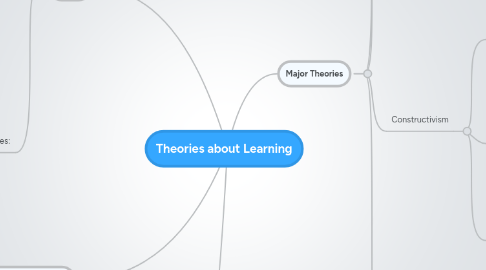
1. Learning theories involving technology
1.1. Media Ecology
1.1.1. Technology profoundly influences society and controls virtually all walks of life
1.1.1.1. communication technology is the primary cause of societal change
1.1.1.1.1. "The medium is the message"
1.1.1.1.2. different mediums engage different senses and repeated exposure to certain mediums conditions a response
1.1.2. study of how media and communication influences human perception and understanding
1.1.2.1. media acts as an extension of the human senses
1.1.2.1.1. Hot media: high definition communication the demands little involvement from audience
1.1.2.1.2. Cool media: demands involvement of audience
1.2. SCoT
1.2.1. Social Construction of Technology
1.2.2. "technology does not determine human action, but rather human action shapes technology"
1.2.3. the way technology is used cannot be separated from the social context in which the technology is used
2. TPACK
2.1. Framework outlining the knowledge teachers need to teach effectively with technology
2.2. Three primary forms of knowledge
2.2.1. Content Knowledge (CK
2.2.1.1. Content in subject area
2.2.1.2. "highly qualified"
2.2.2. Pedagogical Knowledge (PK)
2.2.2.1. classroom strategies
2.2.2.2. application of learning theory
2.2.2.3. differentiation techniques
2.2.2.4. grading practices
2.2.3. Technology Knowledge (TK)
2.2.3.1. Familiarity and mastery of information technology
2.2.3.2. able to support use of technology by students and staff
2.3. Intersecting areas of each form represent four more knowledge bases:
2.3.1. Pedagogical content knowledge (PCK)
2.3.1.1. strong content and good application of learning theory
2.3.2. Technological Content knowledge (TCK)
2.3.2.1. Technology used to enhance content exploration, minimal learning theories usage
2.3.3. Technological Pedagogical knowledge (TPK)
2.3.3.1. Class engaged with technology, but detached from content
2.3.4. Technological Pedagogical Content Knowledge (TPACK)
2.3.4.1. class focused on content, utilizing learning theories supported by technology
3. Philosophy of teachnology
3.1. No, it's not a typo
3.1.1. integration of technology in to application of teaching philosophies
3.1.1.1. how can technology be used to foster constructivist learning?
3.1.1.1.1. building video games!
3.1.1.1.2. making movies!
3.2. Effectively using technology in the classroom relies upon:
3.2.1. Alignment
3.2.1.1. Use of technology must be purposeful, not just as a distraction but illustrating a concept
3.2.2. Accessibility
3.2.2.1. Students must have ready access and be able to easily learn how to utilize the technology. Plan ahead
3.2.3. Assessment
3.2.3.1. Provide learning objectives for students, be clear about expectations for use of technology in class
3.2.4. Reinforcement
3.2.4.1. Use technology to expand upon your lesson, rather than repeating what has already been said
4. Major Theories
4.1. Behaviourism
4.1.1. concerned with the observable behaviours rather than unobservable events in a person's mind
4.1.1.1. behaviour is based on reaction to stimuli
4.1.1.2. reactions can be 'trained'
4.1.1.2.1. Conditioning theories
4.1.2. Watson, Skinner, Pavlov, Thorndike
4.2. Cognitivism
4.2.1. a response to behaviourism
4.2.1.1. cognition can affect behaviour, and as such cannot be behaviour itself, as behaviourists claimed
4.2.2. psychology can be fully explained thru experimentation, observation and the scientific method
4.2.3. cognition consists of discrete internal mental states
4.2.3.1. long term, short term, and working memory
4.2.3.1.1. cognitive strategies can be used to transfer knowledge between them
4.2.3.2. mind representation, mental models
4.2.3.3. thinking is mind manipulation
4.3. Constructivism
4.3.1. emphasizes how people create meaning of the world thru constructs
4.3.1.1. students experience environment first hand, producing trustworthy knowledge of the concepts
4.3.1.2. required to act upon and test environment in order to acquire new knowledge
4.3.2. assumes that the learner is self directed, creative and innovative
4.3.2.1. responsibility for learning is put more upon the learner than the educator
4.3.2.1.1. students must be motivated to learn
4.3.2.2. purpose of the educator is to guide learner in self-directed learning
4.3.2.2.1. 'guide at the side' not 'sage on the stage'
4.3.2.2.2. modify learning constructs and allow for construction of new knowledge
4.3.3. interactive learning
4.3.3.1. educational video games
4.3.3.2. field trips
4.3.3.3. projects
4.4. Cognitive load theory
4.4.1. explains the limits of working memory
4.4.1.1. only 7 items can be held in working memory at one time
4.4.1.2. overload occurs when working memory has to process too much to fast
4.4.1.3. working memory is able to access information from long term memory
4.4.2. Involves the concept of Schemas (situational information put into long term memory)
4.4.2.1. automation is produced by well developed schemas, thru repeated effort and extensive practice
4.4.2.1.1. playing an instrument
4.4.2.1.2. writing an essay
4.4.2.1.3. playing hockey
4.4.3. Three types of cognitive load:
4.4.3.1. Extraneous
4.4.3.1.1. caused by inappropriate instruction that forces working memory to focus on construction of long term memories rather than schemas
4.4.3.2. Intrinsic
4.4.3.2.1. Caused by the irreducible complexity of elements interacting in working memory
4.4.3.3. Germane
4.4.3.3.1. effortful learning resulting in the production of schemas and automation
